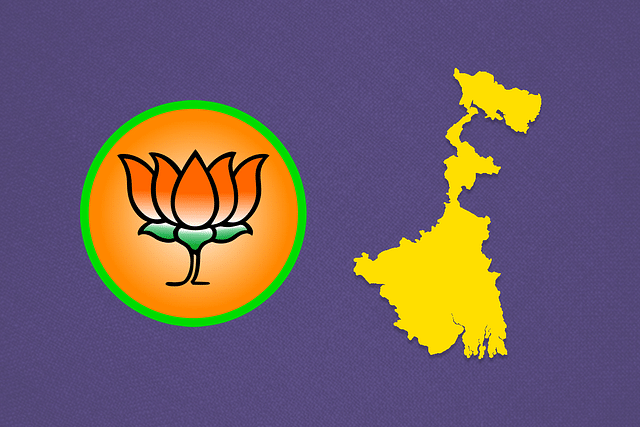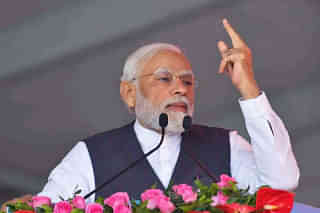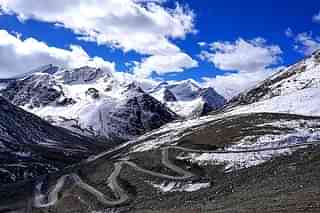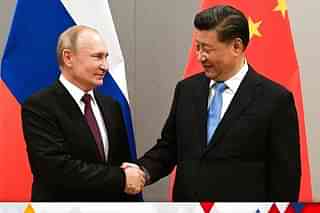Politics
Explained: Why The BJP Receives Overwhelming Support From Bengali Hindus In Tripura And Everywhere Else, But Not In Bengal
Jaideep Mazumdar
Mar 03, 2023, 07:05 PM | Updated 07:05 PM IST
Save & read from anywhere!
Bookmark stories for easy access on any device or the Swarajya app.

The BJP has bagged Tripura for the second time. But this time, the saffron victory can be attributed almost solely to the overwhelming support of the Bengali Hindus who form nearly 68 per cent of the state’s population.
The tribals, who constitute a little less than 30 per cent of Tripura’s population, voted overwhelmingly for the Tipra Motha, which won 13 seats, all of them in the tribal belt. The tribals had supported the BJP and its ally, the IPFT, in 2018.
Despite nearly 30 per cent of the state’s population (the tribals) not supporting it, the BJP managed to win a majority of seats in Tripura. That’s because it managed to consolidate the Bengali Hindus in its favour.
From Uttar Pradesh to Madhya Pradesh to Jharkhand and even Karnataka, BJP draws enormous support among Bengali Hindus settled in non-Bengali speaking states.
But this very same success eluded the BJP in Bengal.
The party could not build further on a certain level of Hindu consolidation it achieved in West Bengal during the 2019 Lok Sabha polls.
It lost some momentum in the 2021 assembly elections, though even here it polled majority of the Hindu votes in the state (a 40 per cent overall vote share in assembly elections points to at least 60 per cent Hindus in West Bengal preferring BJP as the party is likely to have drawn a blank among Muslims).
So what explains this difference in the Bengali Hindu voters' support to the BJP—overwhelming outside Bengal, but not so much within Bengal itself, especially the southern parts?
There are many reasons for that. The salient ones are:
Bengali Hindus consolidated behind the BJP in Tripura because of the perceived threat from the Tipra Motha whose primary demand is a separate state for tribals. Bengali Hindus felt that the Motha’s advocacy of a separate state would trigger tribal insurgency once again.
Tripura has been wracked by tribal insurgency in the past, and Bengali Hindus had suffered a lot. The BJP was perceived to be the best bulwark against the Motha and the centrifugal forces it encouraged. Hence, Bengali Hindus rallied in large numbers behind the BJP.
Almost all Bengali Hindus in Tripura are migrants, or descendants of migrants, who fled horrific religious persecution from erstwhile East Pakistan and present-day Bangladesh. The memories of the terrible oppression they faced are still fresh in their minds and they wholeheartedly support the Citizenship Amendment Act (CAA).
The strong anti-CAA stance adopted by the Left, the Congress and the Tipra Motha resulted in a large number of Bengali Hindus aligning themselves with the BJP.
The CAA worked for the BJP in north Bengal and parts of central Bengal because those areas have a large population of Bengali Hindus who are migrants or descendants of migrants from East Pakistan and Bangladesh.
Also, Bengali Hindus in North Bengal and parts of central Bengal have been facing growing Muslim assertiveness and suffering from the effects of large scale illegal migration of Muslims from Bangladesh. That’s why the BJP’s promise of curbing this influx, identifying illegal migrants from Bangladesh and granting Indian citizenship to the Hindu migrants found strong resonance among Bengali Hindus.
The case of South Bengal was different because it has very few migrants or first generation descendants of migrants from East Pakistan or Bangladesh. Only those Bengali Hindus who migrated from the neighbouring Muslim-majority country in recent decades, or their offspring, remember the traumatic times they faced there. That’s one of the reasons why the BJP could not break the Trinamool’s hold over south Bengal.
The second or third generation descendants of Bengali Hindu migrants in Bengal have no memories of the persecution faced by their grandparents or great grandparents. That’s because the communist-controlled education system in the state has systematically obliterated those memories and whitewashed all accounts of the persecution of Hindus in East Pakistan and Bangladesh in the name of building a ‘secular’ society.
South Bengal is also the epicentre of communists, 'pseudo-secularists' and fake liberals who have established their monopoly over the state’s intellectual space and set the dominant political and social narratives.
This significant group of left or left-leaning educationists, historians, artists, poets, novelists, filmmakers, sociologists, economists and others are looked up to and revered as the buddhijibi (intellectual) bhadralok class.
Though this class was solidly behind the Left till the early part of the last decade, they swiftly switched loyalties to the Trinamool after the latter came to power in Bengal in 2011. Most bhadraloks are dependent on state patronage and, thus, the shift is understandable.
The left-leaning bhadraloks, who shape the cultural and political narrative of the state due to their preponderance in academia, media and various arms of the state, are viscerally opposed to right wing and right-of-centre ideologies, and they have made it their mission to create and spread false narratives against the BJP. Bengali Hindus of south Bengal, many among them being ‘wokes’, buy into such narratives and that has thwarted BJP’s efforts to make inroads into South Bengal.
The BJP also must own some responsibility for its failure to enter and establish itself in the intellectual mindspace of the Bengali Hindus because it reinforced its image as a Hindi heartland party through its strident advocacy of Hindutva, as exemplified by the loud Jai Shree Ram sloganeering that created a negative effect on the sensibilities of the average Bengali Hindu.
The BJP deployed thousands of its Hindi-speaking leaders and workers from UP, Bihar, Jharkhand, Madhya Pradesh, Rajasthan and Haryana to campaign for the party in Bengal in 2021. A large number of ‘minders’ from outside the state overwhelmed the local leadership of the BJP and they, in fact, became the faces of the party in Bengal.
This was not liked by the Bengali Hindus who have been brought up on a strong diet of parochialism and Bengali sub-nationalism. Mamata Banerjee capitalised on this and painted the BJP as a party of ‘outsiders’ espousing aggressive Hindutva.
The BJP in Tripura did not commit this blunder and Bengali leaders from the state itself spearheaded the election campaign. Party minders from outside the state worked behind the scenes. Thus, the opposition could not paint the party as one of outsiders.
In Bengal, the BJP committed the grave error of injudiciously inducting a large number of disgruntled leaders and workers from the Trinamool Congress into its fold before the 2021 elections. This created strong resentment among BJP old-timers and many of the entrants were also Trinamool moles and double-agents who worked against the party (BJP).
The party did not make such a mistake in Tripura. Also, the BJP has been able to build its organisation in Tripura within a short time, but it has dismally failed to do so in Bengal.
In the run-up to the 2021 polls, and even now, the BJP in Bengal was beset with deep differences, ego-clashes, rivalries and power-plays among its leaders. That triggered factionalism among workers and harmed the party’s electoral prospects.
In Tripura, the party has functioned more or less as one cohesive unit and the BJP central leadership has, through timely and firm interventions, addressed differences among state leaders.
All these factors have catapulted the BJP to power in Tripura for the second time, but limited the saffron party’s ambitions in Bengal.
Save & read from anywhere!
Bookmark stories for easy access on any device or the Swarajya app.
Jaideep Mazumdar is an associate editor at Swarajya.
Support Swarajya's 50 Ground Reports Project & Sponsor A Story
Every general election Swarajya does a 50 ground reports project.
Aimed only at serious readers and those who appreciate the nuances of political undercurrents, the project provides a sense of India's electoral landscape. As you know, these reports are produced after considerable investment of travel, time and effort on the ground.
This time too we've kicked off the project in style and have covered over 30 constituencies already. If you're someone who appreciates such work and have enjoyed our coverage please consider sponsoring a ground report for just Rs 2999 to Rs 19,999 - it goes a long way in helping us produce more quality reportage.
You can also back this project by becoming a subscriber for as little as Rs 999 - so do click on this links and choose a plan that suits you and back us.
Click below to contribute.





